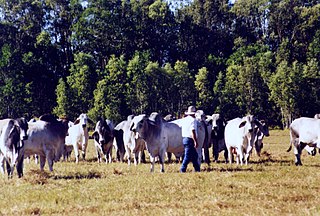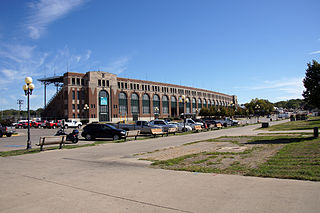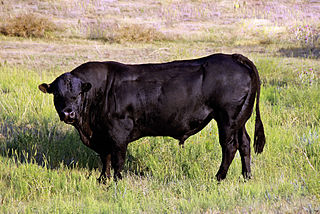
In telecommunications, a network interface device is a device that serves as the demarcation point between the carrier's local loop and the customer's premises wiring. Outdoor telephone NIDs also provide the subscriber with access to the station wiring and serve as a convenient test point for verification of loop integrity and of the subscriber's inside wiring.

In livestock agriculture and the meat industry, a slaughterhouse, also called an abattoir, is a facility where livestock animals are slaughtered to provide food. Slaughterhouses supply meat, which then becomes the responsibility of a meat-packing facility.

A farm is an area of land that is devoted primarily to agricultural processes with the primary objective of producing food and other crops; it is the basic facility in food production. The name is used for specialized units such as arable farms, vegetable farms, fruit farms, dairy, pig and poultry farms, and land used for the production of natural fiber, biofuel, and other commodities. It includes ranches, feedlots, orchards, plantations and estates, smallholdings, and hobby farms, and includes the farmhouse and agricultural buildings as well as the land. In modern times, the term has been extended so as to include such industrial operations as wind farms and fish farms, both of which can operate on land or at sea.

In telephony, the demarcation point is the point at which the public switched telephone network ends and connects with the customer's on-premises wiring. It is the dividing line which determines who is responsible for installation and maintenance of wiring and equipment—customer/subscriber, or telephone company/provider. The demarcation point varies between countries and has changed over time.
Inferences are steps in reasoning, moving from premises to logical consequences; etymologically, the word infer means to "carry forward". Inference is theoretically traditionally divided into deduction and induction, a distinction that in Europe dates at least to Aristotle. Deduction is inference deriving logical conclusions from premises known or assumed to be true, with the laws of valid inference being studied in logic. Induction is inference from particular evidence to a universal conclusion. A third type of inference is sometimes distinguished, notably by Charles Sanders Peirce, contradistinguishing abduction from induction.

A condominium is an ownership regime in which a building is divided into multiple units that are either each separately owned, or owned in common with exclusive rights of occupation by individual owners. These individual units are surrounded by common areas that are jointly owned and managed by the owners of the units. The term can be applied to the building or complex itself, and is sometimes applied to individual units. The term "condominium" is mostly used in the US and Canada, but similar arrangements are used in many other countries under different names.

Plum Island Animal Disease Center (PIADC) is a United States federal research facility dedicated to the study of foreign animal diseases of livestock. It is a national laboratory of the Department of Homeland Security (DHS) Directorate for Science and Technology (S&T), and operates as a partnership with the U.S. Department of Agriculture (USDA). The facility's director is Dr. Larry Barrett.
Natural Resources Conservation Service (NRCS), formerly known as the Soil Conservation Service (SCS), is an agency of the United States Department of Agriculture (USDA) that provides technical assistance to farmers and other private landowners and managers.

There are different systems of feeding cattle in animal husbandry. For pastured animals, grass is usually the forage that composes the majority of their diet. In turn, this grass-fed approach is known for producing meat with distinct flavor profiles. Cattle reared in feedlots are fed hay supplemented with grain, soy and other ingredients to increase the energy density of the feed. The debate is whether cattle should be raised on fodder primarily composed of grass or a concentrate. The issue is complicated by the political interests and confusion between labels such as "free range", "organic", or "natural". Cattle raised on a primarily foraged diet are termed grass-fed or pasture-raised; for example meat or milk may be called grass-fed beef or pasture-raised dairy. The term "pasture-raised" can lead to confusion with the term "free range", which does not describe exactly what the animals eat.

A yard is an area of land immediately adjacent to one or more buildings. It may be either enclosed or open. The word may come from the same linguistic root as the word garden and has many of the same meanings.

Free range denotes a method of farming husbandry where the animals, for at least part of the day, can roam freely outdoors, rather than being confined in an enclosure for 24 hours each day. On many farms, the outdoors ranging area is fenced, thereby technically making this an enclosure, however, free range systems usually offer the opportunity for the extensive locomotion and sunlight that is otherwise prevented by indoor housing systems. Free range may apply to meat, eggs or dairy farming.

In Australia, a stockman is a person who looks after the livestock on a station, traditionally on horse. It has a similar meaning to "cowboy". A stockman may also be employed at an abattoir, feedlot, on a livestock export ship, or with a stock and station agency.
His Majesty's Land Registry is a non-ministerial department of His Majesty's Government, created in 1862 to register the ownership of land and property in England and Wales. It reports to the Department for Levelling Up, Housing and Communities.

The Humane Slaughter Act, or the Humane Methods of Livestock Slaughter Act, is a United States federal law designed to decrease suffering of livestock during slaughter. It was approved on August 27, 1958. The most notable of these requirements is the need to have an animal completely sedated and insensible to pain. This is to minimize the suffering to the point where the animal feels nothing at all, instead blacking out and never waking. This differs from animal to animal as size increases and decreases. Larger animals such as bovines require a stronger method than chickens, for example. Bovines require electronarcosis or something equally potent, though electronarcosis remains a standard. The bovine would have a device placed on their head that, once activated, sends an electric charge that efficiently and safely stuns them. Chickens, on the other hand, require much less current to be efficiently sedated and are given a run under electrically charged water. To ensure that these guidelines are met, the Food Safety and Inspection Service inspectors at slaughtering plants are responsible for overseeing compliance, and have the authority to stop slaughter lines and order plant employees to take corrective actions. Although more than 168 million chickens and around 9 billion broiler chickens are killed for food in the United States yearly, the Humane Slaughter Act specifically mentions only cattle, calves, horses, mules, sheep and swine.

Fiber to the x or fiber in the loop is a generic term for any broadband network architecture using optical fiber to provide all or part of the local loop used for last mile telecommunications. As fiber optic cables are able to carry much more data than copper cables, especially over long distances, copper telephone networks built in the 20th century are being replaced by fiber.
The National Animal Identification System, (naisG) is a government-run program in the United States intended to extend government animal health surveillance by identifying and tracking specific animals. Administered at the federal level by the Animal and Plant Health Inspection Service, a branch of the United States Department of Agriculture, NAIS will also be overseen by state animal health boards. While the federal program is voluntary, money received by some states, tribes, and non-profit entities from the USDA through cooperative agreements has been used to make parts or all of the program mandatory.

Motor vehicle registration is the registration of a motor vehicle with a government authority, either compulsory or otherwise. The purpose of motor vehicle registration is to establish a link between a vehicle and an owner or user of the vehicle. While almost all motor vehicles are uniquely identified by a vehicle identification number, only registered vehicles display a vehicle registration plate and carry a vehicle registration certificate. Motor vehicle registration is different from motor vehicle licensing and roadworthiness certification.

Livestock are the domesticated animals raised in an agricultural setting in order to provide labour and produce diversified products for consumption such as meat, eggs, milk, fur, leather, and wool. The term is sometimes used to refer solely to animals who are raised for consumption, and sometimes used to refer solely to farmed ruminants, such as cattle, sheep, and goats. Horses are considered livestock in the United States. The USDA classifies pork, veal, beef, and lamb (mutton) as livestock, and all livestock as red meat. Poultry and fish are not included in the category. The latter is likely due to the fact that fish products are not governed by the USDA, but by the FDA.

The Iowa State Fairgrounds is located on the east side of Des Moines, Iowa. It annually hosts the Iowa State Fair in late summer. The state fair was begun in Iowa in 1854 and the current fairgrounds were established in 1886. The fairgrounds were listed as a historic district on the National Register of Historic Places in 1987 as the Iowa State Fair and Exposition Grounds.

North American Piedmontese cattle are a breed of domestic beef cattle originating from an imported herd of select Italian purebred Piedmontese cattle. The foundation line of breeding stock was first imported from Italy into Canada in 1979, and into the United States in the early 1980s. Piedmontese cattle are distinguished by a unique, naturally occurring gene identified as the myostatin allele mutation, or inactive myostatin gene. Myostatin prohibits muscle growth whereas an inactive gene has the opposite effect. Purebred Piedmontese are homozygous,, which means they have two identical alleles present for this unique gene. Research indicates the presence of the myostatin allele mutation produces morphological characteristics unique to the breed, such as double-muscling, beef tenderness, reduced fat content and high yield. According to the North American Piedmontese Association (NAPA), they are the first breed registry to base animal registration requirements on the presence of this specific gene which can be easily verified by DNA testing.















